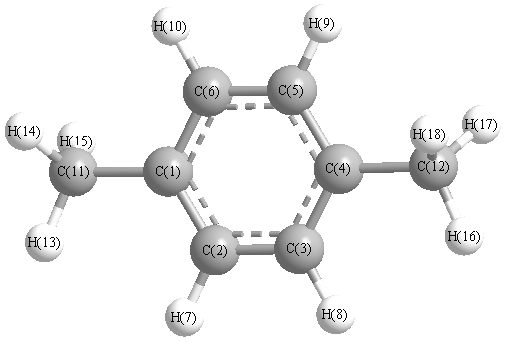Geometric Data

Point Group C2v
Internal coordinates
distances (r) in Å, angles (a) in degrees, dihedrals (d) in degrees
| Description |
Value |
unc. |
Connectivity |
Reference |
Comment |
| Atom 1 |
Atom 2 |
Atom 3 |
Atom 4 |
Cartesians
Atom - Atom Distances 
Distances in Å
Calculated geometries
for CH
3C
6H
4CH
3 (paraxylene).
Bond descriptions
Examples: C-C single bond, C=C, double bond, C#C triple bond, C:C aromatic bond
| Bond Type |
Count |
| C-C |
2 |
| C:C |
6 |
| H-C |
10 |
Connectivity
| Atom 1 |
Atom 2 |
| C1 |
C2 |
| C1 |
C6 |
| C1 |
C11 |
| C2 |
C3 |
| C2 |
H7 |
| C3 |
C4 |
| C3 |
H8 |
| C4 |
C5 |
| C4 |
C12 |
| C5 |
C6 |
| C5 |
H9 |
| C6 |
H10 |
| C11 |
H13 |
| C11 |
H14 |
| C11 |
H15 |
| C12 |
H16 |
| C12 |
H17 |
| C12 |
H18 |









